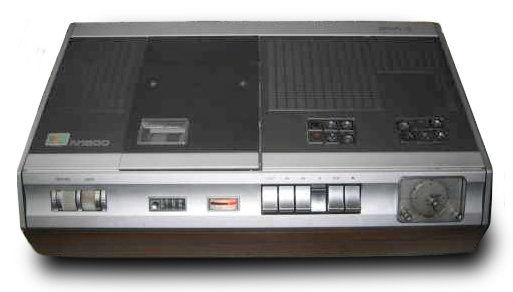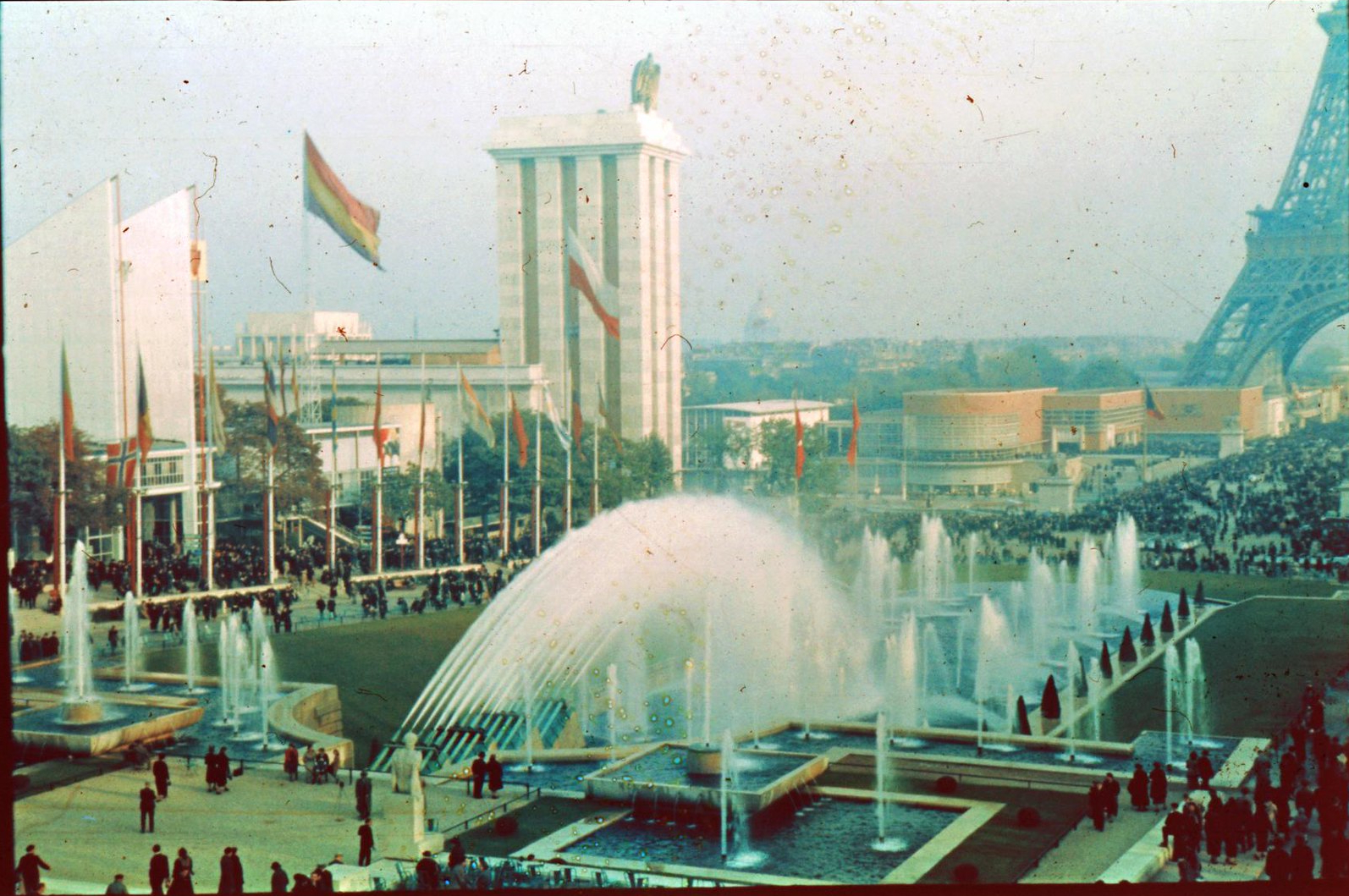|
Video Cassette Recording
Video Cassette Recording (VCR) is an early domestic analog recording format designed by Philips. It was the first successful consumer-level home videocassette recorder (VCR) system. Later variants included the VCR-LP and Super Video (SVR) formats. The VCR format was introduced in 1972, just after the Sony U-matic format in 1971. Although at first glance the two might appear to have been competing formats, they were aimed at very different markets. After failing as a consumer format, U-matic was marketed as a professional television production format, whilst VCR was targeted particularly at educational but also domestic users. Unlike some other early formats such as Cartrivision, the VCR format does record a high-quality video signal without resorting to Skip field. Home video systems had previously been available, but they were open-reel systems (such as the Sony CV-2000) and were expensive to both buy and operate. They were also unreliable and often only recorded in black a ... [...More Info...] [...Related Items...] OR: [Wikipedia] [Google] [Baidu] |
Video Recording
Video is an electronic medium for the recording, copying, playback, broadcasting, and display of moving visual media. Video was first developed for mechanical television systems, which were quickly replaced by cathode-ray tube (CRT) systems, which, in turn, were replaced by flat-panel displays of several types. Video systems vary in display resolution, aspect ratio, refresh rate, color capabilities, and other qualities. Analog and digital variants exist and can be carried on a variety of media, including radio broadcasts, magnetic tape, optical discs, computer files, and network streaming. Etymology The word ''video'' comes from the Latin verb ''video,'' meaning to see or ''videre''. And as a noun, "that which is displayed on a (television) screen," History Analog video Video developed from facsimile systems developed in the mid-19th century. Early mechanical video scanners, such as the Nipkow disk, were patented as early as 1884, however, it took several decade ... [...More Info...] [...Related Items...] OR: [Wikipedia] [Google] [Baidu] |
Philips VC60 Video Cassette Recording Tape (rear With Tape Exposed) (from MoOM)
Koninklijke Philips N.V. (), simply branded Philips, is a Dutch multinational health technology company that was founded in Eindhoven in 1891. Since 1997, its world headquarters have been situated in Amsterdam, though the Benelux headquarters is still in Eindhoven. The company gained its royal honorary title in 1998. Philips was founded by Gerard Philips and his father Frederik, with their first products being light bulbs. Through the 20th century, it grew into one of the world's largest electronics conglomerates, with global market dominance in products ranging from kitchen appliances and electric shavers to light bulbs, televisions, cassettes, and compact discs (both of which were invented by Philips). At one point, it played a dominant role in the entertainment industry (through PolyGram). However, intense competition from primarily East Asian competitors throughout the 1990s and 2000s led to a period of downsizing, including the divestment of its lighting and con ... [...More Info...] [...Related Items...] OR: [Wikipedia] [Google] [Baidu] |
Agfa-Gevaert
Agfa-Gevaert N.V. (Agfa) is a Belgian-German multinational corporation that develops, manufactures, and distributes analogue and digital imaging products, software, and systems. The company began as a dye manufacturer in 1867. In 1925, the company merged with several other German chemical companies to become chemicals giant IG Farben. IG Farben would go on to play major role in the economy of Nazi Germany. It extensively employed forced labour during the Nazi period, and produced Zyklon B poison gas used in the Holocaust. IG Farben was disestablished by the Allies in 1945. AGFA was reconstituted (as a subsidiary of Bayer) from the remnants of IG Farben in 1952. Agfa photographic film and cameras were once prominent consumer products. In 2004, the consumer imaging division was sold to a company founded via management buyout. AgfaPhoto GmbH, as the new company was called, filed for bankruptcy after a year, [...More Info...] [...Related Items...] OR: [Wikipedia] [Google] [Baidu] |
EMTEC
EMTEC markets consumer computer data storage products and other computer related consumables. The company is part of the Dexxon Group, headquartered in Gennevilliers, France. EMTEC evolved from BASF Magnetics, originally producing magnetic tapes. Since its origin, EMTEC has undergone several transformations. Between 1998 and 2002 all of BASF's cassette lineup (Ferro Extra, Chrome Extra and Chrome Super, along with the budget tapes Sound 1 and Sound 2) were rebranded EMTEC. While cassette manufacture has since ceased in 2005, and reel-to-reel tape operations were sold to RMGI, EMTEC continues to manufacture other recordable media such as optical discs, memory cards, and USB flash drives. Distribution channels have decreased and EMTEC presence in the market is a shadow of its former BASF self. History * ~1930s — High quality magnetic tape is developed at I.G.Farben's Ludwigshafen plant. * 1945~1952 — I.G Farben is broken up into several companies, including ... [...More Info...] [...Related Items...] OR: [Wikipedia] [Google] [Baidu] |
Grundig
Grundig ( , , ) is a Turkish home appliances and consumer electronics brand. It is owned by Arçelik A.Ş., the white goods (major appliance) manufacturer of Turkish conglomerate Koç Holding. Originally a German consumer electronics company, Grundig GmbH was founded in 1945 by Max Grundig and was headquartered for the most part in Nuremberg until its insolvency in 2003. The Grundig company helped fuel the post-war economic miracle of West Germany and it grew to become one of the leading manufacturers in the world of radio, TV, recording and other electronic equipment in the following decades. In the 1970s, Philips began acquiring Grundig's shares, leading to complete control in 1993, but Philips divested Grundig by 1998. Grundig filed for bankruptcy in April 2003 after years of losses and strong competition from cheaper Asian competitors. Most of the former Grundig business was acquired by a Turkish-British joint venture of Beko and Alba in 2004, who relaunched the Gr ... [...More Info...] [...Related Items...] OR: [Wikipedia] [Google] [Baidu] |
SVR Video Recorder
SVR may refer to: Biology and medicine * Systemic vascular resistance * Sustained viral response in hepatitis C treatment Companies and organizations *Foreign Intelligence Service (Russia) ( rus, Служба внешней разведки Российской Федерации, r=Sluzhba vneshney razvedki Rossiyskoy Federatsii , p=ˈsluʐbə ˈvnʲɛʂnʲɪj rɐˈzvʲɛtkʲɪ) * Second Vermont Republic, a US secessionist group * Reykjavík bus company merged into Strætó bs * SV Ried, an Austrian soccer club * SVR Producciones, a Chilean record label * Sons of Veterans Reserve, of the Sons of Union Veterans of the Civil War Finance * Scottish variable rate of income tax * Standard variable rate for mortgages Media * WWE 2K, formerly WWE Smackdown VS. Raw. * WWE Smackdown! VS. Raw (2004 video game) * '' WWE SmackDown! vs. Raw 2006'' * ''WWE SmackDown vs. Raw 2007'' * '' WWE SmackDown vs. Raw 2008'' * ''WWE SmackDown vs. Raw 2009'' * ''WWE SmackDown vs. Raw 2010'' * ''WWE S ... [...More Info...] [...Related Items...] OR: [Wikipedia] [Google] [Baidu] |
Philips N1702
Koninklijke Philips N.V. (), simply branded Philips, is a Dutch multinational health technology company that was founded in Eindhoven in 1891. Since 1997, its world headquarters have been situated in Amsterdam, though the Benelux headquarters is still in Eindhoven. The company gained its royal honorary title in 1998. Philips was founded by Gerard Philips and his father Frederik, with their first products being light bulbs. Through the 20th century, it grew into one of the world's largest electronics conglomerates, with global market dominance in products ranging from kitchen appliances and electric shavers to light bulbs, televisions, cassettes, and compact discs (both of which were invented by Philips). At one point, it played a dominant role in the entertainment industry (through PolyGram). However, intense competition from primarily East Asian competitors throughout the 1990s and 2000s led to a period of downsizing, including the divestment of its lighting and cons ... [...More Info...] [...Related Items...] OR: [Wikipedia] [Google] [Baidu] |
NTSC
NTSC (from National Television System Committee) is the first American standard for analog television, published and adopted in 1941. In 1961, it was assigned the designation System M. It is also known as EIA standard 170. In 1953, a second NTSC standard was adopted, which allowed for color television broadcast compatible with the existing stock of black-and-white receivers. It is one of three major color formats for analog television, the others being PAL and SECAM. ''NTSC color'' is usually associated with the System M; this combination is sometimes called NTSC II. The only other broadcast television system to use NTSC color was the System J. Brazil used System M with PAL color. Vietnam, Cambodia and Laos used System M with SECAM color – Vietnam later started using PAL in the early 1990s. The NTSC/System M standard was used in most of the Americas (except Argentina, Brazil, Paraguay, and Uruguay), Myanmar, South Korea, Taiwan, Philippines, Japan, and some Pacific Isl ... [...More Info...] [...Related Items...] OR: [Wikipedia] [Google] [Baidu] |
Slant Azimuth
Helical scan is a method of recording high-frequency signals on magnetic tape, used in open-reel video tape recorders, video cassette recorders, digital audio tape recorders, and some computer tape drives. With this technique, magnetic tape heads (or head chips) are placed on a rotating head drum, which moves the chips at high speed by due to its high angular velocity. The speed of the head chips must be higher than the linear speed of the tape. The tape is wrapped tightly around the drum. The drum and/or the tape is tilted at an angle that allows the head chips to read the tape diagonally. The linear speed of the tape is slower than the speed of the head chips, allowing high frequency signals to be read or recorded, such as video. As the tape moves linearly or length-wise, the head chips move across the width of the tape in a diagonal path. Due to geometry, this allows for high head chip speeds, known as writing speeds, to be achieved in spite of the low linear speed of the tape. ... [...More Info...] [...Related Items...] OR: [Wikipedia] [Google] [Baidu] |
Video Tape
Videotape is magnetic tape used for storing video and usually sound in addition. Information stored can be in the form of either an analog or digital signal. Videotape is used in both video tape recorders (VTRs) and, more commonly, videocassette recorders (VCRs) and camcorders. Videotapes have also been used for storing scientific or medical data, such as the data produced by an electrocardiogram. Because video signals have a very high bandwidth, and stationary heads would require extremely high tape speeds, in most cases, a helical-scan video head rotates against the moving tape to record the data in two dimensions. Tape is a linear method of storing information and thus imposes delays to access a portion of the tape that is not already against the heads. The early 2000s saw the introduction and rise to prominence of high-quality random-access video recording media such as hard disks and flash memory. Since then, videotape has been increasingly relegated to archival and s ... [...More Info...] [...Related Items...] OR: [Wikipedia] [Google] [Baidu] |






